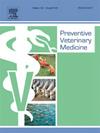Abattoir monitoring of liver lesions caused by Ascaris suum larvae: A longitudinal study conducted in northern Italy
IF 2.4
2区 农林科学
Q1 VETERINARY SCIENCES
引用次数: 0
Abstract
Introduction
Data supplied by the abattoir monitoring system offer a useful tool both for tracing the prevalence of Ascaris suum milk spot lesions and for conducting large-scale epidemiological studies.
Materials
In this study, livers of 754833 slaughtered pigs from 5835 batches and 399 farms located in northern Italy, were evaluated in one of the largest national abattoirs during a year of survey. From each farm data concerning the breeding region and province, the season of post-mortem inspection, the farm size and the type of farm production were collected and the probability of finding a positive animal, i.e. with at least one milk spot lesion, in relation to these factors was estimated by a generalised linear mixed model (GLMM).
Results
368 out of 399 farms tested positive (92.2 %), out of 5835 batches of animals, 4395 (75.3 %) had at least one positive pig, and out of 754833 carcasses, 198964 showed milk spots, with an overall prevalence of 26.4 %. The breeding province and the season of post-mortem inspection were two significant risk factors: a higher risk of finding animals with milk spots was recorded in some Italian provinces and in spring.
Conclusions
This study provides data on the prevalence of milk spots caused by A. suum migrating larvae in an area characterised by a high density of pig farms. Given the high prevalence recorded, it is necessary to promote effective communication between abattoir, veterinarians and farmers, monitoring the circulation of A. suum, developing specific control plans and enhancing animal health surveillance.
由猪蛔虫幼虫引起的肝脏损害的屠宰场监测:在意大利北部进行的一项纵向研究
屠宰场监测系统提供的数据为追踪猪蛔虫奶斑病的流行情况和开展大规模流行病学研究提供了有用的工具。在这项研究中,研究人员在意大利北部最大的屠宰场之一进行了为期一年的调查,对来自5835批次、399个农场的754833头屠宰猪的肝脏进行了评估。从有关养殖地区和省的每个养殖场数据中,收集了死后检查的季节、养殖场规模和农场生产类型,并通过广义线性混合模型(GLMM)估计了与这些因素相关的发现阳性动物的概率,即至少有一个奶斑病变。结果399个养殖场中有368个(92.2 %)呈阳性,5835个批次中有4395个(75.3 %)至少有1头猪呈阳性,754833头胴体中有198964头出现乳斑,总流行率为26.4% %。繁殖省份和死后检查季节是两个重要的危险因素:意大利一些省份和春季记录的发现有奶斑动物的风险较高。结论本研究提供了猪场密度较高地区猪棘球绦虫迁徙幼虫引起的乳斑流行情况。鉴于记录的高流行率,有必要促进屠宰场、兽医和农民之间的有效沟通,监测猪单螺旋体的传播,制定具体的控制计划并加强动物健康监测。
本文章由计算机程序翻译,如有差异,请以英文原文为准。
求助全文
约1分钟内获得全文
求助全文
来源期刊

Preventive veterinary medicine
农林科学-兽医学
CiteScore
5.60
自引率
7.70%
发文量
184
审稿时长
3 months
期刊介绍:
Preventive Veterinary Medicine is one of the leading international resources for scientific reports on animal health programs and preventive veterinary medicine. The journal follows the guidelines for standardizing and strengthening the reporting of biomedical research which are available from the CONSORT, MOOSE, PRISMA, REFLECT, STARD, and STROBE statements. The journal focuses on:
Epidemiology of health events relevant to domestic and wild animals;
Economic impacts of epidemic and endemic animal and zoonotic diseases;
Latest methods and approaches in veterinary epidemiology;
Disease and infection control or eradication measures;
The "One Health" concept and the relationships between veterinary medicine, human health, animal-production systems, and the environment;
Development of new techniques in surveillance systems and diagnosis;
Evaluation and control of diseases in animal populations.
 求助内容:
求助内容: 应助结果提醒方式:
应助结果提醒方式:


